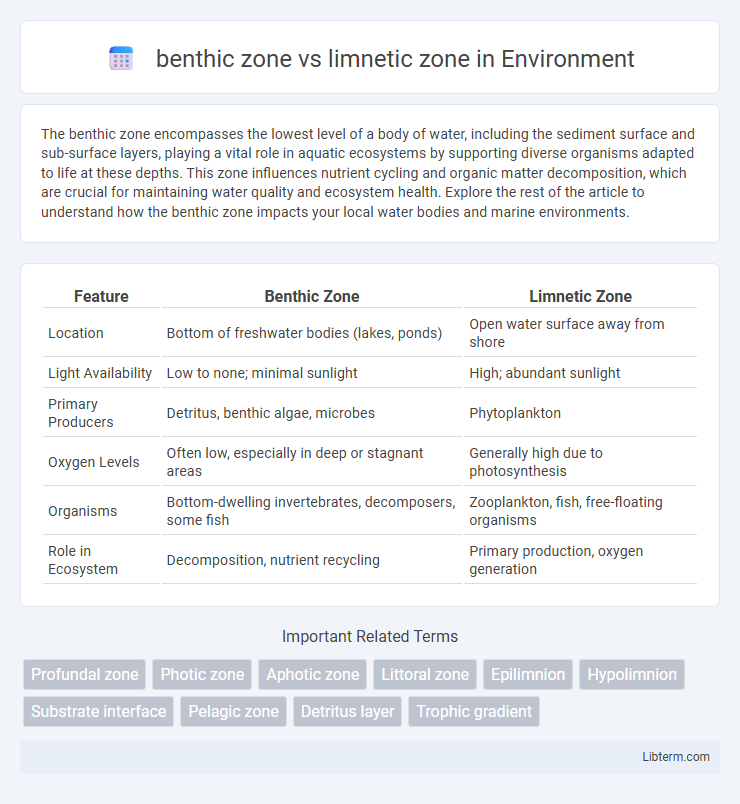The benthic zone encompasses the lowest level of a body of water, including the sediment surface and sub-surface layers, playing a vital role in aquatic ecosystems by supporting diverse organisms adapted to life at these depths. This zone influences nutrient cycling and organic matter decomposition, which are crucial for maintaining water quality and ecosystem health. Explore the rest of the article to understand how the benthic zone impacts your local water bodies and marine environments.
Table of Comparison
| Feature | Benthic Zone | Limnetic Zone |
|---|---|---|
| Location | Bottom of freshwater bodies (lakes, ponds) | Open water surface away from shore |
| Light Availability | Low to none; minimal sunlight | High; abundant sunlight |
| Primary Producers | Detritus, benthic algae, microbes | Phytoplankton |
| Oxygen Levels | Often low, especially in deep or stagnant areas | Generally high due to photosynthesis |
| Organisms | Bottom-dwelling invertebrates, decomposers, some fish | Zooplankton, fish, free-floating organisms |
| Role in Ecosystem | Decomposition, nutrient recycling | Primary production, oxygen generation |
Introduction to Aquatic Zones
The benthic zone refers to the ecological region at the bottom of a water body, including the sediment surface and some sub-surface layers, supporting organisms like decomposers and bottom-feeders. The limnetic zone is the well-lit, open surface water area away from the shore, dominated by plankton and free-swimming organisms, crucial for photosynthesis. Understanding the distinct physical and biological characteristics of these zones aids in studying aquatic ecosystems and their biodiversity.
Definition of Benthic Zone
The benthic zone refers to the ecological region at the lowest level of a body of water, including the sediment surface and some sub-surface layers. It hosts a diverse community of organisms, such as benthos, which are adapted to live in or on the bottom substrate. In contrast, the limnetic zone is the well-lit, open surface waters away from the shore where photosynthesis primarily occurs.
Definition of Limnetic Zone
The limnetic zone is the well-lit, open surface waters of a lake or pond, extending down to the depth where sunlight penetrates enough for photosynthesis to occur. It supports a variety of plankton, fish, and other aquatic organisms dependent on sunlight and oxygen-rich water. In contrast, the benthic zone refers to the bottom substrate of a water body, characterized by limited light and inhabited by decomposers and bottom-dwelling species.
Key Differences Between Benthic and Limnetic Zones
The benthic zone is the lowest ecological region in a lake or ocean, characterized by sediment-covered floors and inhabited by organisms like decomposers, bottom feeders, and detritivores, whereas the limnetic zone is the well-lit, open water area away from the shore, dominated by plankton, fish, and photosynthetic algae. Oxygen levels tend to be higher in the limnetic zone due to photosynthesis, while the benthic zone often has lower oxygen concentrations and relies on organic material falling from upper layers for energy. Temperature and light penetration vary significantly, with the limnetic zone experiencing more light and thermal stratification compared to the darker, cooler benthic environment where scavenging and nutrient recycling occur.
Physical Characteristics of Each Zone
The benthic zone, located at the bottom of a water body, features a substrate composed of mud, sand, and organic matter, with lower temperatures and reduced light penetration. The limnetic zone encompasses the well-lit, open surface waters away from the shore, characterized by higher oxygen levels and abundant photosynthetic activity due to direct sunlight exposure. Variations in depth, temperature, light availability, and substrate composition distinctly differentiate the physical environment of the benthic and limnetic zones.
Light Penetration and Temperature Variations
The limnetic zone receives abundant light penetration, supporting photosynthesis by phytoplankton and maintaining relatively stable, warmer temperatures due to direct sunlight exposure. In contrast, the benthic zone is characterized by minimal to no light penetration, leading to limited photosynthetic activity and cooler, more variable temperatures influenced by sediment and water depth. These differences critically affect the biological communities and metabolic processes distinct to each aquatic zone.
Types of Organisms Found in Benthic and Limnetic Zones
The benthic zone hosts bottom-dwelling organisms such as decomposers, detritivores, and benthic invertebrates like worms, mollusks, and crustaceans adapted to sediment environments. In contrast, the limnetic zone contains primarily plankton, including phytoplankton and zooplankton, as well as free-swimming fish species that thrive in open, well-lit waters. The distinct habitat conditions drive unique ecological communities in each zone, with benthic organisms playing a crucial role in nutrient recycling and limnetic organisms contributing to primary production and energy flow.
Ecological Roles and Functions
The benthic zone serves as a critical habitat for decomposers and detritivores, recycling nutrients by breaking down organic matter on the lake or ocean floor, which supports nutrient cycling and sustains benthic food webs. The limnetic zone, characterized by open, well-lit waters, primarily supports photosynthetic phytoplankton, forming the foundation of aquatic food chains and driving primary production. Together, these zones maintain ecosystem balance through complementary roles in energy flow and nutrient dynamics within freshwater and marine environments.
Human Impact on Benthic and Limnetic Zones
Human activities such as industrial pollution and agricultural runoff introduce harmful chemicals and excess nutrients into both benthic and limnetic zones, disrupting aquatic ecosystems and leading to habitat degradation. Benthic zones, being sediment-rich bottom layers, accumulate toxins and heavy metals, threatening benthic organisms and benthic food webs. Limnetic zones, composed of open water away from shore, experience eutrophication and oxygen depletion, harming plankton populations and fish species dependent on clear, oxygen-rich waters.
Summary: Benthic Zone vs Limnetic Zone
The benthic zone comprises the bottom substrate of a water body, including sediments and the organisms living there, characterized by low light and oxygen levels. The limnetic zone represents the well-lit, open water area away from the shore, supporting phytoplankton and free-swimming organisms. These zones differ primarily in depth, light availability, and ecological communities, influencing nutrient cycling and aquatic biodiversity.
benthic zone Infographic

 libterm.com
libterm.com